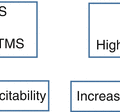© Springer International Publishing AG 2018
Stefano Masiero and Ugo Carraro (eds.)Rehabilitation Medicine for Elderly PatientsPractical Issues in Geriatricshttps://doi.org/10.1007/978-3-319-57406-6_3535. Neurobehavioral Rehabilitation of Visual Deficits in Older Patients
(1)
Department of General Psychology, University of Padua, Padua, Italy
35.1 Neuroplasticity in Aging
Aging is associated with a progressive slowing down of information processing and with a diminished capacity in encoding, representing, and maintaining information, as well as in selecting relevant information and discarding irrelevant one. These changes are associated, at neurobiological level, with a neuromodulatory decline. A correlation has been suggested between cognitive decline and the decrease in cholinergic markers, although the role of Ach in modulating learning and memory may not be specific [1]. The level of acetylcholine (Ach) affects neural spatial integration and may be related to the states of arousal and attention [2]. In the aged human cortex, genes involved in GABA-mediated inhibitory neurotransmission are downregulated [3], thus affecting low-level cortical balance between excitation and inhibition in sensory tasks [4–8]. Specifically, reduced strength of surround suppression in the central visual system, a visual function essential for isolating object contours and region boundaries in crowded natural scenes, may result from age-related reduced efficiency of GABAergic inhibitory mechanisms in the visual cortex [9]. Moreover, age-dependent reduction in the ability to signal visual sensory stimuli above background activity (signal-to-noise ratio) is likely to have deficient dopaminergic modulation as a neurochemical correlate [10].
Cerebral metabolic decline is associated with inefficient interneuronal communication with consequent reduced efficacy of interconnections among neurons in brain areas involved not only in cognitive but also in sensory processing. Indeed, MRI (Magnetic Resonance Imaging) data reveal a significant age-associated reduction of the size of visual cortical areas V1, V2, and to lesser extent V3, possibly associated with a decreased number of cortical connections [11].
Changes in synaptic connections affect cortical plasticity in the aged brain as assessed by the measurement of age-dependent threshold variation for long-lasting modulation in synaptic signal transmission (long-term potentiation and depression, LTP and LTD) [12].
In addition to changes in brain activation, neuromodulatory-dependent impairment of cortical and subcortical representations of sensory inputs determines a self-reinforcing downward spiral of reduced interaction with challenging environments, which significantly contributes to cognitive decline. Not only does alteration of neural information processing lead to less distinct neural representations and memory traces, but it also results in a more simplified behavior. In adapting to this reduced complexity, the brain simplifies even more the representations supporting perception and action. Age-related cognitive decline is therefore a problem of brain plasticity with negative consequences.
A large and growing body of human studies have documented that plasticity with negative consequences in the older brain can be reversed. The therapeutic target is to induce plasticity with positive consequences in the older brain by modulating the balance between excitatory and inhibitory networks. Extensive basic research focused on the role of endogenous neuromodulator release such as norepinephrine, acetylcholine, serotonin, or dopamine in regulating positively excitation-inhibition balance [13]. A different approach, either independent or combined with regulation of endogenous neuromodulation, is to induce neuroplasticity neurobehaviorally. This is achieved through perceptual learning (PL), a long-term sensitivity improvement with some basic sensory tasks as a result of active training on that task. Through PL, physical and functional decline can be slowed down, arrested, and inverted [14]. Neurobehavioral training resulting in PL strengthens neuromodulatory control, enhances LTP, restores neural connections, increases signal-to-noise ratio, and improves the specificity of cortical representations [15].
Neural plasticity induced neurobehaviorally by PL reduces sensory deficits by improving neural representations which become narrowly tuned along physical dimensions. Moreover, because low- and high-level brain mechanisms work together to process incoming information at increasing levels of complexity, it may be expected that neurobehavioral training resulting in PL in low-level task would transfer to higher-level functions. Decades of cumulative research have provided evidence that PL mediates cortical plasticity, thus engaging competitive brain networks so as to refine the selective representation of sensory input and transfer these improvements to interacting systems.
35.2 Improvement of Visual Functions in Healthy Aging
PL has been shown to improve a variety of visual functions. One recent study revealed a PL improvement of contrast sensitivity in older adults. After 7 days of training using a forced-choice orientation discrimination task, older adult’s performance was as good as that of younger adults prior to training. The effects of PL were independent of retinal illuminance changes and transferred to untrained orientations but not to visual acuity [16]. Orientation discrimination was found to improve in older adults during training, in particular when the orientation discrimination task was difficult and the orientation to be discriminated was embedded in additive visual noise [17]. Training to discriminate the direction of motion of sine wave gratings (an image where the luminance varies as a sign wave) embedded in visual noise reduced contrast threshold in the elderly and the effect of PL transferred to other motion tasks, suggesting higher tolerance to external noise rather than reduction of additive internal noise [18]. Importantly, PL of motion tasks involving low-level central visual mechanisms transfers to higher-level visual functions [19]. Berry and coworkers [19] trained older participants in discriminating the expansion/contraction of a sine wave grating presented within a 2D Gaussian window and found, 10 h later, better performance in the older group that was trained during the 10-h interval relative to the untrained control group. Training transferred to an untrained task consisting in discriminating whether two consecutive directions of coherently moving dots were the same or different, both when the task was purely perceptual and, most importantly, when working memory was involved by interposing a delay between the two stimuli. Moreover, the electrophysiological response to the stimulus (event-related brain potentials, ERPs) was recorded. The comparison of ERPs measured at two intervals showed a training-dependent modulation of the deflection of a negative voltage component with a latency of 120–220 ms (N1). The amplitude of this component was significantly decreased at the second interval for the trained, but not for the control group. Moreover, PL has been shown in tasks approximating real-world demands of dividing attention simultaneously among multiple stimuli and tasks. For example, Richards et al. [20] involved younger and older observers in PL of a useful field of view task (UFOV), in which participants performed the localization of peripheral targets. Performance in this task was impaired by engaging simultaneously attention to a central letter which observers had to identify. However, in both groups, the impairment due to divided attention was reduced, and, when older subjects were provided with enough practice, their attentional costs did not differ from those of the younger group.
In addition to the evidence of PL-dependent improvement in aging, several studies provide evidence that PL is associated with brain plasticity. Chang et al. [11] involved observers in three training sessions. They found a 28% reduction of temporal threshold, defined as the interval between texture and mask to reach 80% accuracy in a texture discrimination task (TDT). Before, PL thresholds in TDT were uncorrelated with areal size of V1, V2, or V3 for all groups. For the older group only, individual improvement due to PL was significantly correlated with areal size of V3. Importantly, for the older group, the correlation between PL effects and areal size was found in V3, whereas in younger adults, PL is associated with a specific modulation of functional activation in the trained location of V1 [21–24]. Note that V3 shows the smallest age-associated size reduction. This could explain why it compensates for the age-dependent reduced functional plasticity of V1. Indeed, assuming that reduced areal size reflects a reduction in the number of facilitatory and inhibitory connections whose strength is modulated by PL [25], this would affect negatively the potentiality of PL in areas of reduced size such as V1, whereas PL would be preserved in larger areas with a larger number of neural connections, such as V3.
In addition to changes in areal size, it has been shown [26] that PL leads to a change in cortical connectivity in the older brain. The study was based on the hypothesis that PL potentiates signal transmission as indexed by fractional anisotropy (FA) that reflects neural properties such myelin thickness and axonal diameter. Younger and older observers were involved in PL of TDT, and FA values associated with PL were obtained using two MRI techniques: diffusion tensor imaging, a MRI technique that can measure macroscopic axonal organization in nervous system, and functional MRI BOLD signals elicited during the task. Results showed that the older but not the younger group showed significant changes in FA, suggesting a different PL mechanism in the two groups: only in older observer PL is associated with a reorganization of white matter.
Altogether, neurobehavioral and MRI findings suggest that sensory plasticity is preserved for training in older adults.
35.3 Rehabilitation of Visual Diseases in Elderly
In the present session, we review evidence of positive outcomes resulting from the rehabilitation of sensory diseases in older patients. We focus on presbyopia, optic neuropathy, and age-related macular degeneration.
Presbyopia
Presbyopia is a common type of refractive error associated with the experience of blurred vision which causes limitation in daily activities such as reading, sewing, or working at the computer and goes together with a reduction of near visual acuity, contrast sensitivity, and processing speed. The consequence of blurred input to the cortex may be a reduced neural activation and a sluggish neural response. Based on the hypothesis that blurred vision results in less efficient spatiotemporal neural coding, Polat et al. [27] involved presbyopic observes in a neurovisual training protocol, consisting in detecting a low-contrast target presented with high-contrast collinear and iso-oriented flankers. They showed that PL resulted in improved visual acuity and contrast sensitivity. Most importantly, reading speed improved by 17 words/min following training.
Stay updated, free articles. Join our Telegram channel

Full access? Get Clinical Tree





